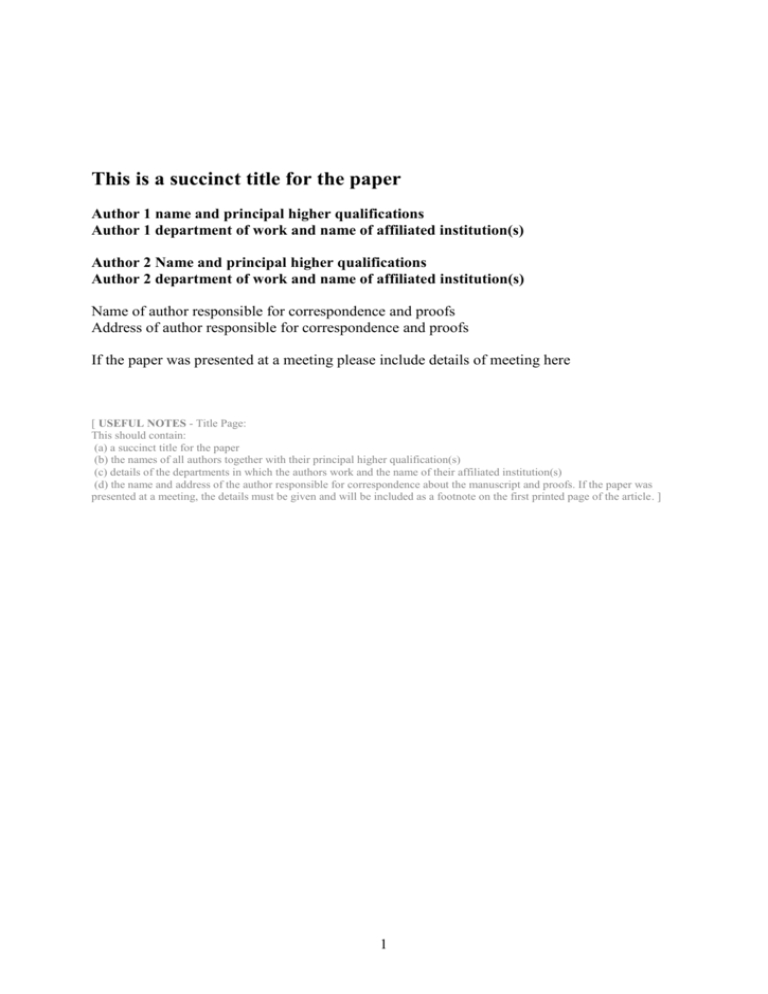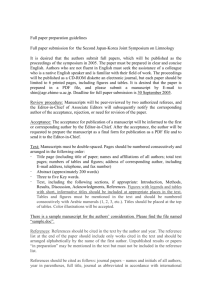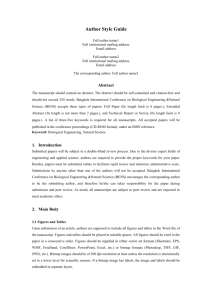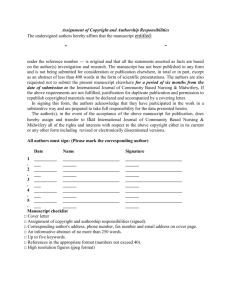Template
advertisement

This is a succinct title for the paper Author 1 name and principal higher qualifications Author 1 department of work and name of affiliated institution(s) Author 2 Name and principal higher qualifications Author 2 department of work and name of affiliated institution(s) Name of author responsible for correspondence and proofs Address of author responsible for correspondence and proofs If the paper was presented at a meeting please include details of meeting here [ USEFUL NOTES - Title Page: This should contain: (a) a succinct title for the paper (b) the names of all authors together with their principal higher qualification(s) (c) details of the departments in which the authors work and the name of their affiliated institution(s) (d) the name and address of the author responsible for correspondence about the manuscript and proofs. If the paper was presented at a meeting, the details must be given and will be included as a footnote on the first printed page of the article. ] 1 Abstract Abstract of 150 words (max.), which should include a statement of the problem, the method of study, the results obtained and the conclusions drawn. Keywords Keywords that can be used to index the article. Only the words appearing as Medical Subject Headings (MeSH) in the supplement to Index Medicus may ordinarily be used. [ USEFUL NOTES - Abstract and Key Words: The abstract should be no longer than 150 words and should include a statement of the problem, the method of study, the results obtained and the conclusions drawn. A separate 'summary' section in the main manuscript is not permitted. Following the abstract should be those key words which can be used to index the article. Only the words appearing as Medical Subject Headings (MeSH) in the supplement to Index Medicus may ordinarily be used; in exceptional circumstances, and where no appropriate word(s) are listed, those dictated by common usage should be supplied. No paper will be accepted without an abstract and appropriate key words. ] 2 Text The text should normally follow the common outlines, i.e. Introduction Materials and methods Results and analysis Fig.1 Information about Fig.1 Discussion Conclusion(s) The latter sections should clearly indicate how this work fits with the current body of world literature. [ USEFUL NOTES - Text: The text should normally follow the common outlines, i.e.,introduction, materials and methods, results and analysis, discussion, conclusion(s). The latter sections should clearly indicate how this work fits with the current body of world literature. Illustrations: Tables and charts should be adjuncts to the text and must not repeat material already presented. They should be numbered consecutively, with Roman numerals, and must be marked with a clear legend. Photographic illustrations should be unmounted, should not exceed 80 mm in width and should be high quality black and white prints; reproduction of coloured prints will normally be charged to the authors. Two sets of photographic illustrations, one with each copy of the manuscript, should be supplied and each should be clearly identified on the back with the figure number and the first author's name. Where any ambiguity might result the top edge should be identified with an arrow to aid orientation. Colour illustrations from papers are occasionally selected by the editor for use on the front cover of the journal at no cost to the authors. If appropriate a colour version of one of the black and white photographs submitted can be included for this purpose. Photomicrographs of histopathological specimens must be accompanied by details of the staining method and the magnification used. Photographs which could result in the person illustrated being identified must be accompanied by a signed release giving specific consent to publication. For minors, signed parental permission is required. Written permission from the publisher to reproduce any illustration (or table) with copyright elsewhere must be obtained and, where necessary, the consent of the senior author must also be acquired. Measurements: These must be in metric units with Systeme Internationale(SI) equivalents given in parentheses. Drugs: The approved names of drugs should be used. One reference to a proprietary name may be given if this is felt to be important to the study. ] 3 Acknowledgements Add any acknowledgements here… 4 References 1 2 3 Kalan A, Kenyon GS, Seemungal TAR, Wedzicha JA. Adverse effects of nasal continuous positive airway pressure therapy in sleep apnoea syndrome. J Laryngol Otol 1999;113:888--92 Pryse-Phillips W. Companion to Clinical Neurology. Boston: Little Brown, 1995 Sullivan CE, Grunstein RR. Continuous positive airway pressure in sleep-disordered breathing. In: Kryger MH, Roth T, Dement WC, eds. Principles and Practice of Sleep Medicine, 2nd edn. Philadelphia: WB Saunders, 1994: 694--705 [ USEFUL NOTES - References: Authors should personally verify the accuracy of references before submitting a paper for publication. The Vancouver system should be used. References should be identified in the text by superscript arabic numerals, and be numbered and listed consecutively at the end of the manuscript in the order in which they are first cited in the text. References must include: names and initials of all authors (unless more than 6, when only the first 6 are given followed by et al.); the title of the paper; the journal title abbreviated as in Index Medicus; year of publication; volume number; first and last page numbers. References to books should give the author(s) or editor(s), book title, place of publication, publisher and year; those to chapters in books should also include the chapter title, first and last page numbers, and the names and initials of chapter authors. For example: 1. Kalan A, Kenyon GS, Seemungal TAR, Wedzicha JA. Adverse effects of nasal continuous positive airway pressure therapy in sleep apnoea syndrome. J Laryngol Otol 1999;113:888--92 2. Pryse-Phillips W. Companion to Clinical Neurology. Boston: Little Brown, 1995 3. Sullivan CE, Grunstein RR. Continuous positive airway pressure in sleep-disordered breathing. In: Kryger MH, Roth T, Dement WC, eds. Principles and Practice of Sleep Medicine, 2nd edn. Philadelphia: WB Saunders, 1994: 694--705 ] 5 Tables and Charts TABLE I Title for table I Column 1 Column 2 Column 3 Row 1 Row 2 TABLE II Title for table II Column 1 Column 2 Column 3 Row 1 Row 2 [ USEFUL NOTES – Tables and Legends: Tables and charts should be adjuncts to the text and must not repeat material already presented. They should be numbered consecutively, with Roman numerals, and must be marked with a clear legend. ] 6





